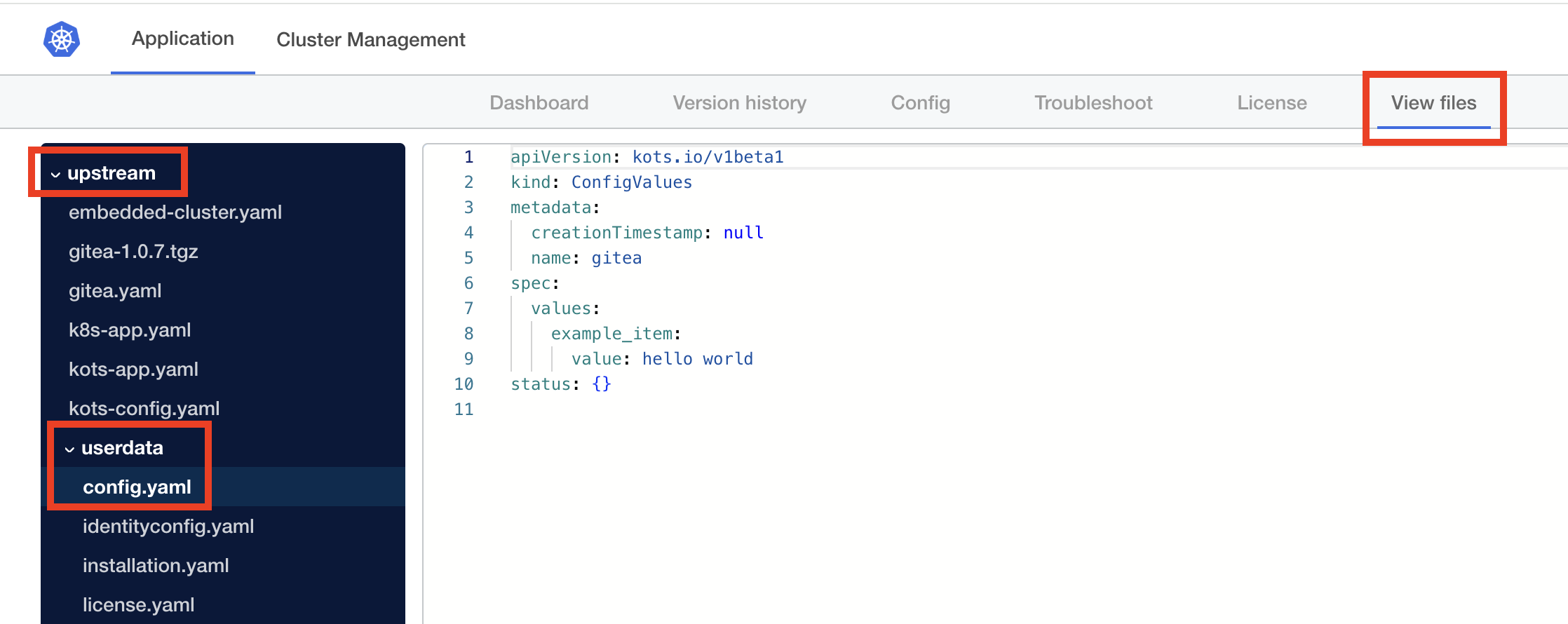Install with kURL from the Command Line
Replicated kURL is available only for existing customers. If you are not an existing kURL user, use Replicated Embedded Cluster instead. For more information, see Use Embedded Cluster.
kURL is a Generally Available (GA) product for existing customers. For more information about the Replicated product lifecycle phases, see Support Lifecycle Policy.
This topic describes how to install an application with Replicated kURL from the command line.
Overview
You can use the command line to install an application with Replicated kURL. A common use case for installing from the command line is to automate installation, such as performing headless installations as part of CI/CD pipelines.
To install from the command line, you provide all the necessary installation assets, such as the license file and the application config values, with the installation command rather than through the Admin Console UI. Any preflight checks defined for the application run automatically during headless installations from the command line rather than being displayed in the Admin Console.
Prerequisite
Create a ConfigValues YAML file to define the configuration values for the application release. The ConfigValues file allows you to pass the configuration values for an application from the command line with the install command, rather than through the Admin Console UI. For air-gapped environments, ensure that the ConfigValues file can be accessed from the installation environment.
The KOTS ConfigValues file includes the fields that are defined in the KOTS Config custom resource for an application release, along with the user-supplied and default values for each field, as shown in the example below:
apiVersion: kots.io/v1beta1
kind: ConfigValues
spec:
values:
config_item_name:
default: example_default_value
value: example_value
boolean_config_item_name:
value: "1"
password_config_item_name:
valuePlaintext: exampleplaintextpassword
select_one_config_item_name:
default: default_option_name
value: selected_option_name
During installation, KOTS automatically generates a ConfigValues file and saves the file in a directory called upstream. After installation, you can view the generated ConfigValues file in the Admin Console View files tab or from the command line by running the kubectl kots get config command.
To get the ConfigValues file from an installed application instance:
-
Install the target release in a development environment. You can either install the release with Replicated Embedded Cluster or install in an existing cluster with KOTS. For more information, see Online Installation with Embedded Cluster or Online Installation in Existing Clusters with KOTS.
-
Depending on the installer that you used, do one of the following to get the ConfigValues for the installed instance:
-
For Embedded Cluster installations: In the Admin Console, go to the View files tab. In the filetree, go to upstream > userdata and open config.yaml, as shown in the image below:

-
For KOTS installations in an existing cluster: Run the
kubectl kots get configcommand to view the generated ConfigValues file:kubectl kots get config --namespace APP_NAMESPACE --decryptWhere:
APP_NAMESPACEis the cluster namespace where KOTS is running.- The
--decryptflag decrypts all configuration fields withtype: password. In the downloaded ConfigValues file, the decrypted value is stored in avaluePlaintextfield.
The output of the
kots get configcommand shows the contents of the ConfigValues file. For more information about thekots get configcommand, including additional flags, see kots get config.
-
Online (Internet-Connected) Installation
When you use the KOTS CLI to install an application in a kURL cluster, you first run the kURL installation script to provision the cluster and automatically install KOTS in the cluster. Then, you can run the kots install command to install the application.
To install with kURL on a VM or bare metal server:
-
Create the kURL cluster:
curl -sSL https://k8s.kurl.sh/APP_NAME | sudo bash -
Install the application in the cluster:
kubectl kots install APP_NAME \
--shared-password PASSWORD \
--license-file PATH_TO_LICENSE \
--config-values PATH_TO_CONFIGVALUES \
--namespace default \
--no-port-forwardReplace:
-
APP_NAMEwith a name for the application. This is the unique name that KOTS will use to refer to the application that you install. -
PASSWORDwith a shared password for accessing the Admin Console. -
PATH_TO_LICENSEwith the path to your license file. See Downloading Customer Licenses. For information about how to download licenses with the Vendor API v3, see Download a customer license file as YAML in the Vendor API v3 documentation. -
PATH_TO_CONFIGVALUESwith the path to the ConfigValues file.
NAMESPACEwith the namespace where Replicated kURL installed Replicated KOTS when creating the cluster. By default, kURL installs KOTS in thedefaultnamespace.
-
Air Gap Installation
To install in an air-gapped kURL cluster:
-
Download the kURL
.tar.gzair gap bundle:export REPLICATED_APP=APP_SLUG
curl -LS https://k8s.kurl.sh/bundle/$REPLICATED_APP.tar.gz -o $REPLICATED_APP.tar.gzWhere
APP_SLUGis the unqiue slug for the application. -
In your installation environment, extract the contents of the kURL
.tar.gzbundle that you downloaded:tar -xvzf $REPLICATED_APP.tar.gz -
Create the kURL cluster:
cat install.sh | sudo bash -s airgap -
Install the application:
kubectl kots install APP_NAME \
--shared-password PASSWORD \
--license-file PATH_TO_LICENSE \
--config-values PATH_TO_CONFIGVALUES \
--airgap-bundle PATH_TO_AIRGAP_BUNDLE \
--namespace default \
--no-port-forwardReplace:
-
APP_NAMEwith a name for the application. This is the unique name that KOTS will use to refer to the application that you install. -
PASSWORDwith a shared password for accessing the Admin Console. -
PATH_TO_LICENSEwith the path to your license file. See Downloading Customer Licenses. For information about how to download licenses with the Vendor API v3, see Download a customer license file as YAML in the Vendor API v3 documentation. -
PATH_TO_CONFIGVALUESwith the path to the ConfigValues file.
-
PATH_TO_AIRGAP_BUNDLEwith the path to the.airgapbundle for the application release. You can build and download the air gap bundle for a release in the Vendor Portal on the Release history page for the channel where the release is promoted.Alternatively, for information about building and downloading air gap bundles with the Vendor API v3, see Trigger airgap build for a channel's release and Get airgap bundle download URL for the active release on the channel in the Vendor API v3 documentation.
NAMESPACEwith the namespace where Replicated kURL installed Replicated KOTS when creating the cluster. By default, kURL installs KOTS in thedefaultnamespace.
-